Aspheric Fiber Collimators, Pigtailed PM Fiber
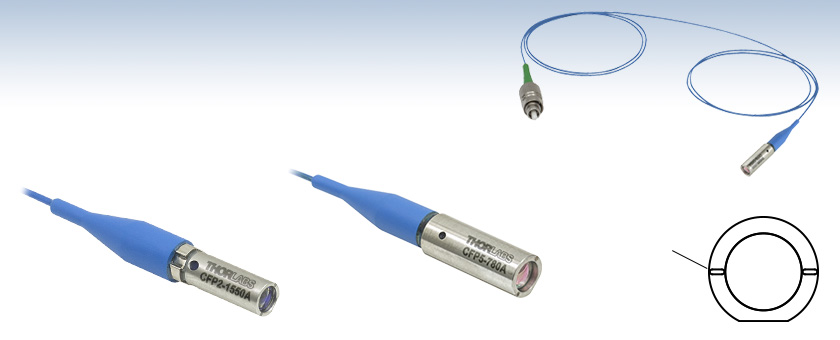
- 1 m PM Fiber Pigtail with FC/APC Connector
- Five Alignment Wavelengths from 633 nm to 1550 nm
- Custom Alignment Wavelengths Available
CFP5-1064A
1064 nm, FC/APC Collimator
Focal Length: 4.67 mm
CFP2-1550A
1550 nm, FC/APC Collimator
Focal Length: 2.05 mm
CFP5-780A
780 nm, FC/APC Collimator
Focal Length: 4.63 mm
Engraved Line Parallel to
Fast Axis

Please Wait
| Quick Links to Available Wavelengths |
|---|
| 633 nm |
| 780 nm |
| 980 nm |
| 1064 nm |
| 1550 nm |
Features
- PM Fiber Pigtail with FC/APC Connector
- Custom Wavelengths and Connectors Available by Contacting Tech Support
- Non-Magnetic Stainless Steel Housing
The CFP series of pigtailed fiber collimators is a compact solution for a wide variety of applications. The collimation package consists of a stainless steel housing and an aspheric lens. Each unit uses 1 m of polarization-maintaining fiber pigtailed to the collimation package so that the performance of the collimator is diffraction limited at the design wavelength. As shown in the family image above, the engraved line on the outside of the housing is parallel to the fast axis. As such, it can be used as a reference when polarized light is launched accordingly.
The fiber end pigtailed to the collimation package is angle-polished and AR-coated to minimize reflections at the design wavelength. There is negligible deflection caused by the angled output over the short focal lengths of the CFP2 and CFP5 collimators, allowing them to have straight housings, instead of angled housings. The other end of the fiber has an FC/APC, 2.0 mm narrow key connector. These collimation packages can be easily customized for any wavelength in the visible and near IR spectral regions. In addition, the fiber connector, fiber type, and fiber length can all be customized; please contact Tech Support for a quote.
| θ | Divergence Angle |
| D | Mode-Field Diameter (MFD) |
| f | Focal Length of Collimator |
The divergence angle (in Degrees) ,
,
where D and f must be in the same units.
Divergence Angle Comparison
The divergence angle can be estimated using the formula shown to the right, given that the light emerging from the fiber has a Gaussian intensity profile. This formula works well for single mode fibers, like those found on these pigtailed collimators, but will underestimate the divergence angle for multimode fibers where the light emerging from the fiber has a non-Gaussian intensity profile.
Simulations of the theoretical divergence when using one of our standard collimators at wavelengths other than the design wavelength are shown in the graphs below. For example, if you need to collimate 700 nm light from a fiber, the CFP5-780F collimator (represented by the '-780' line in the CFP5 graph below) can be used but will provide a higher divergence than at its design wavelength of 780 nm. Individual theoretical divergence plots are also available below for each collimator. Please contact Tech Support to request a collimator aligned at a custom wavelength.
| d | Beam Diameter |
| λ | Wavelength |
| f | Focal Length of Collimator |
| MFD | Mode-Field Diameter |
The beam diameter (in millimeters) ,
,
where λ and MFD must be in the same units.
Theoretical Approximation of the Divergence Angle
The 1/e2 beam diameter as a function of propagation distance was simulated for each of our collimators at the design wavelength, assuming input from the design fiber and a Gaussian intensity profile. The formula shown to the right is an approximation for these beam diameters. This works well for single mode fibers, like those found on these pigtailed collimators, but will underestimate the beam diameter for multimode fibers where the light emerging from the fiber has a non-Gaussian intensity profile.
Theoretical Approximation of the Divergence Angle
The full-angle beam divergence listed in the specifications tables is the theoretically-calculated value associated with the fiber collimator. This divergence angle is easy to approximate theoretically using the formula below as long as the light emerging from the fiber has a Gaussian intensity profile. Consequently, the formula works well for single mode fibers, but it will underestimate the divergence angle for multimode (MM) fibers since the light emerging from a multimode fiber has a non-Gaussian intensity profile.
The Full Divergence Angle (in degrees) is given by

where MFD is the mode field diameter and f is the focal length of the collimator. (Note: MFD and f must have the same units in this equation).
Example:
When the F220FC-A collimator (f ≈ 11.0 mm; not exact since the design wavelength is 543 nm) is used to collimate 515 nm light emerging from a 460HP fiber (MFD = 3.5 µm), the divergence angle is approximately given by
θ ≈ (0.0035 mm / 11.0 mm) x (180 / pi) = 0.018°.
When the beam divergence angle was measured for the F220FC-A collimator, a 460HP fiber was used with 543 nm light. The result was a divergence angle of 0.018°.
Theoretical Approximation of the Output Beam Diameter
The output beam diameter can be approximated from

where λ is the wavelength of light being used, MFD is the mode field diameter, and f is the focal length of the collimator. (Note: MFD and f must have the same units in this equation).
Example:
When the F240FC-1550 collimator (f = 8.18 mm) is used with the P1-SMF28E-FC-1 patch cable (MFD = 10.4 µm) and 1550 nm light, the output beam diameter is
d ≈ (4)(0.00155 mm)[8.18 mm / (pi · 0.0104 mm)] = 1.55 mm.
Theoretical Approximation of the Maximum Waist Distance
The maximum waist distance, which is the furthest distance from the lens the waist can be located in order to maintain collimation, may be approximated by

where f is the focal length of the collimator, λ is the wavelength of light used, and MFD is the mode field diameter. (Note: MFD and f must have the same units in this equation).
Example:
When the F220FC-532 collimator (f = 10.9 mm) is used with the P1-460B-FC-1 patch cable (MFD ≈ 4.0 µm; calculated approximate value) and 532 nm light, then the maximum waist distance is approximately
zmax ≈ 10.9 mm + [2 · (10.9 mm)2 · 0.000532 mm] / [pi · (0.004 mm)2] = 2526 mm.
Insights into Best Lab Practices
Scroll down to read about a practice we follow when setting up lab equipment.
- Align Fiber Collimators to Create Free Space Between Fibers
Click here for more insights into lab practices and equipment.
Align Fiber Collimators to Create Free Space Between Fibers
Two collimators, inserted into a fiber optic setup, provide free-space access to the beam. The first collimator accepts the highly diverging light from the first fiber and outputs a free-space beam, which propagates with an approximately constant diameter to the second collimator. The second collimator accepts the free-space beam and couples that light into the second fiber. Some collimation packages, including the pair used in this demonstration, are designed for use with optical fibers and mate directly to fiber connectors.
Ideally, 100% of the light emitted by the first fiber would be coupled into the second fiber, but some light will always be lost due to reflections, scattering, absorption, and misalignment. Misalignment, typically the largest source of loss, can be minimized using the alignment and stabilization techniques described in this video.
In this demonstration, the first fiber is single mode. The optical power incident on the second collimator, as well as the power output by the second fiber, are measured. When the second fiber is multimode with a 50 µm diameter core, alignment resulted in 91% of the power incident on the second collimator being measured at the fiber output. This value was 86% when the second fiber is single mode. Some differences in collimator designs, and their effects on the characteristics of the collimated beams, are also discussed.
If you would like more information about tips, tricks, and other methods we often use in the lab, we recommend our other Video Insights. In addition, our webinars provide practical and theoretical introductions to our different products.
| Products Featured During Demonstration | ||||
|---|---|---|---|---|
| Fiber-Coupled Laser | Kinematic Mounts | Fiber Adapter Cap (for Power Sensor) |
Single Mode Patch Cable (FC/PC) | Fiber Cable Storage Reels |
| Triplet Fiber Optic Collimators | Power Sensor | Power Meter | Hybrid Single Mode Patch Cable | 2" Posts |
| Adapter (Mount-to-Collimator) |
SM1 Thread Adapter (for Power Sensor) |
Fiber Connector Cleaner | Step-Index Multimode Patch Cable | Ø1/2" Post Holders |
Date of Last Edit: April 21, 2021
| Posted Comments: | |
lulu li
(posted 2024-04-23 16:40:09.69) 这款准直器能不能接638nm的光啊 cdolbashian
(posted 2024-04-26 01:38:10.0) Thank you for reaching out to us. The question asked, translated, is as follows: Can this collimator receive 638nm light?. This collimator contains an aspheric lens aligned to 1550nm. While it technically can be used fairly well for collimation, when used in reverse, you would likely see very low coupling efficiency due to chromatic focal shift. Adela Collado
(posted 2024-04-15 11:05:33.547) Hello,
I would like to know if this collimator can be used in reverse, as a light colector which collimates sun light into the PM 1550-XP fiber that will enter a system and not to collimate a laser input. If not, I would like to know which collimator could be used like this.
Thank you in advance. cdolbashian
(posted 2024-05-06 09:52:27.0) Thank you for reaching out to us with this inquiry. It is certainly possible to use a collimator in reverse for coupling. That being said, a singlet collimator/coupler is not suitable for broadband light coupling into PM fibers. I have contacted you with some considerations as well as some recommendations of the best way to optimize your coupling. Franziska Weickert
(posted 2020-10-07 04:19:02.37) Hallo,
Ich möchte anfragen, ob das kombinierte Bauteil Faser-Kollimator CFP5-1064A
1) auch für eine Wellenlänge 1083nm optimiert werden kann und
2) ob man dieses mit 4m Faserlänge bestellen könnte?
Wenn ja, können Sie mir dafür ein Angebot erstellen?
Danke,
Franziska Weickert YLohia
(posted 2020-10-07 08:56:06.0) Hello Franziska, thank you for contacting Thorlabs. An applications engineer from our team in Germany (europe@thorlabs.com) will reach out to you directly regarding this. Max K.
(posted 2020-03-10 10:06:09.533) Dear Sir or Madame,
is the CFP5-1064A collimator suitable to collimate the output of a 8 W fiber laser?
Best
Max YLohia
(posted 2020-03-10 03:49:22.0) Hello Max, thank you for contacting Thorlabs. I have reached out to you directly to discuss this and gather more information about your source. |
Fiber Collimator Selection Guide
Click on the collimator type or photo to view more information about each type of collimator.
| Type | Description | |
|---|---|---|
| Fixed FC, APC, or SMA Fiber Collimators | 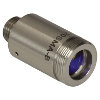 |
These fiber collimation packages are pre-aligned to collimate light from an FC/PC-, FC/APC-, or SMA-terminated fiber. Each collimation package is factory aligned to provide diffraction-limited performance for wavelengths ranging from 405 nm to 4.55 µm. Although it is possible to use the collimator at detuned wavelengths, they will only perform optimally at the design wavelength due to chromatic aberration, which causes the effective focal length of the aspheric lens to have a wavelength dependence. |
| Air-Spaced Doublet, Large Beam Collimators | 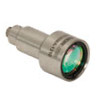 |
For large beam diameters (Ø5.3 - Ø8.5 mm), Thorlabs offers FC/APC, FC/PC, and SMA air-spaced doublet collimators. These collimation packages are pre-aligned at the factory to collimate a laser beam propagating from the tip of an FC or SMA-terminated fiber and provide diffraction-limited performance at the design wavelength. |
| Triplet Collimators | 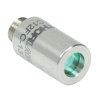 |
Thorlabs' High Quality Triplet Fiber Collimation packages use air-spaced triplet lenses that offer superior beam quality performance when compared to aspheric lens collimators. The benefits of the low-aberration triplet design include an M2 term closer to 1 (Gaussian), less divergence, and less wavefront error. |
| Achromatic Collimators for Multimode Fiber | 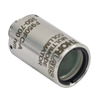 |
Thorlabs' High-NA Achromatic Collimators pair a meniscus lens with an achromatic doublet for high performance across the visible to near-infrared spectrum with low spherical aberration. Designed for use with high-NA multimode fiber, these collimators are ideal for Optogenetics and Fiber Photometry applications. |
| Reflective Collimators |  |
Thorlabs' metallic-coated Reflective Collimators are based on a 90° off-axis parabolic mirror. Mirrors, unlike lenses, have a focal length that remains constant over a broad wavelength range. Due to this intrinsic property, a parabolic mirror collimator does not need to be adjusted to accommodate various wavelengths of light, making them ideal for use with polychromatic light. Our fixed reflective collimators are recommended for collimating single and multimode fiber and coupling into multimode fiber. These collimators are available with UV-enhanced aluminum or protected silver reflective coatings and with FC/PC, FC/APC, or SMA connector compatibility. |
| Compact Reflective Collimators | 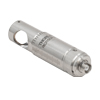 |
Thorlabs' Compact Reflective Collimators incorporate a 90° off-axis parabolic mirror with a protected silver coating. Because the focal length is independent of wavelength for an off-axis parabolic mirror, they are ideal for use with polychromatic light. Our fixed reflective collimators are recommended for collimating single and multimode fiber and coupling into multimode fiber. These collimators are directly compatible with our 16 mm cage system. They are available with FC/PC, FC/APC, or SMA connector inputs. |
| Adjustable Reflective Collimators | 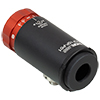 |
Thorlabs' Adjustable Focus Reflective Collimators are based on a 90° off-axis parabolic (OAP) mirror with a protected silver coating. The adjustable fiber-to-OAP distance, combined with the OAP having a constant focal length across wavelengths, makes these collimators ideal for optimizing collimation or coupling of polychromatic light with single mode or multimode fiber. These adjustable collimators have a 15 mm reflected focal length and are available with FC/PC, FC/APC, or SMA connectors. |
| FiberPorts | 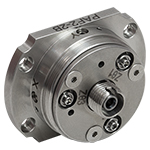 |
These compact, ultra-stable FiberPort micropositioners provide an easy-to-use, stable platform for coupling light into and out of FC/PC, FC/APC, or SMA terminated optical fibers. It can be used with single mode, multimode, or PM fibers and can be mounted onto a post, stage, platform, or laser. The built-in aspheric or achromatic lens is available with five different AR coatings and has five degrees of alignment adjustment (3 translational and 2 pitch). The compact size and long-term alignment stability make the FiberPort an ideal solution for fiber coupling, collimation, or incorporation into OEM systems. |
| Adjustable Fiber Collimators |  |
These collimators are designed to connect onto the end of an FC/PC, FC/APC, or SMA connector and contain an AR-coated aspheric lens. The distance between the aspheric lens and the tip of the fiber can be adjusted to compensate for focal length changes or to recollimate the beam at the wavelength and distance of interest. |
| Achromatic Fiber Collimators with Adjustable Focus |  |
Thorlabs' Achromatic Fiber Collimators with Adjustable Focus are designed with an effective focal length (EFL) of 20 mm, 40 mm, or 80 mm, have optical elements broadband AR coated for one of three wavelength ranges, and are available with FC/PC, FC/APC, or SMA905 connectors. A four-element, air-spaced lens design produces superior beam quality (M2 close to 1) and less wavefront error when compared to aspheric lens collimators. These collimators can be used for free-space coupling into a fiber, collimation of output from a fiber, or in pairs for collimator-to-collimator coupling over long distances, which allows the beam to be manipulated prior to entering the second collimator. |
| Zoom Fiber Collimators | 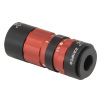 |
These collimators provide a variable focal length between 6 and 18 mm, while maintaining the collimation of the beam. As a result, the size of the beam can be changed without altering the collimation. This universal device saves time previously spent searching for the best suited fixed fiber collimator and has a very broad range of applications. They are offered with FC/PC, FC/APC, or SMA905 connectors with three different antireflection wavelength ranges to choose from. |
| Single Mode Pigtailed Collimators | 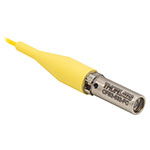 |
Our single mode pigtailed collimators come with one meter of fiber, consist of an AR-coated aspheric lens pre-aligned with respect to a fiber, and are collimated at one of eight wavelengths: 532 nm, 633 nm, 780 nm, 850 nm, 1030 nm, 1064 nm, 1310 nm, or 1550 nm. Although it is possible to use the collimator at any wavelength within the coating range, the coupling loss will increase as the wavelength is detuned from the design wavelength. |
| Polarization Maintaining Pigtailed Collimators | 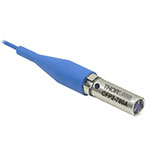 |
Our polarization maintaining pigtailed collimators come with one meter of fiber, consist of an AR-coated aspheric lens pre-aligned with respect to a fiber, and are collimated at one of five wavelengths: 633 nm, 780 nm, 980 nm, 1064 nm, or 1550 nm. Custom wavelengths and connectors are available as well. A line is engraved along the outside of the housing that is parallel to the fast axis. As such, it can be used as a reference when polarized light is launched accordingly. Although it is possible to use the collimator at any wavelength within the coating range, the coupling loss will increase as the wavelength is detuned from the design wavelength. |
| GRIN Fiber Collimators | 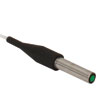 |
Thorlabs offers gradient index (GRIN) fiber collimators that are aligned at a variety of wavelengths from 630 to 1550 nm and have either FC terminated, APC terminated, or unterminated fibers. Our GRIN collimators feature a Ø1.8 mm clear aperture, are AR-coated to ensure low back reflection into the fiber, and are coupled to standard single mode or graded-index multimode fibers. |
| GRIN Lenses | 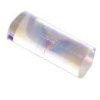 |
These graded-index (GRIN) lenses are AR coated for applications at 630, 830, 1060, 1300, or 1560 nm that require light to propagate through one fiber, then through a free-space optical system, and finally back into another fiber. They are also useful for coupling light from laser diodes into fibers, coupling the output of a fiber into a detector, or collimating laser light. Our GRIN lenses are designed to be used with our Pigtailed Glass Ferrules and GRIN/Ferrule sleeves. |

| Item # | Alignment Wavelengtha |
Lens AR Coating |
Minimum Extinction Ratiob |
Waist Diameterc |
Waist Distanced |
Full-Angle Divergencee |
NALens | Focal Length at Alignment Wavelength |
Clear Aperture |
Housing Outer Diameter |
Connector Type |
|---|---|---|---|---|---|---|---|---|---|---|---|
| 633 nm | 350 - 700 nm Ravg < 0.5% |
20 dB | 0.86 mm | 4.09 mm | (0.94 +0.17 / -0.00 mrad) |
0.53 | 4.59 mm | Ø3.0 mm | 5.7 mmf | 2.0 mm Narrow Key FC/APC |
| Fiber Type | Fiber Length | Insertion Loss | Return Loss | Mode Field Diameter |
|---|---|---|---|---|
| PM630-HP | 1 m | <1.2 dB | ≥50 dB | 4.5 ± 0.5 µm @ 630 nm |

| Item # | Alignment Wavelengtha |
Lens AR Coating |
Minimum Extinction Ratiob |
Waist Diameterc |
Waist Distanced |
Full-Angle Divergencee |
NALens | Focal Length at Alignment Wavelength |
Clear Aperture |
Housing Outer Diameter |
Connector Type |
|---|---|---|---|---|---|---|---|---|---|---|---|
| CFP2-780A | 780 nm | 600 - 1050 nm Ravg < 0.5% |
20 dB | 0.41 mm | 1.99 mm | (2.45 +0.17 / -0.00 mrad) |
0.50 | 2.00 mm | Ø2.0 mm | 4.0 mmf | 2.0 mm Narrow Key FC/APC |
| 780 nm | Ravg < 0.5% |
20 dB | 0.94 mm | 4.13 mm | (1.06 +0.17 / -0.00 mrad) |
0.53 | 4.63 mm | Ø3.0 mm | 5.7 mmg |
| Fiber Type | Fiber Length | Insertion Loss | Return Loss | Mode Field Diameter |
|---|---|---|---|---|
| PM780-HP | 1 m | <1.0 dB | ≥50 dB | 5.3 ± 1.0 µm @ 850 nm |

| Item # | Alignment Wavelengtha |
Lens AR Coating |
Minimum Extinction Ratiob |
Waist Diameterc |
Waist Distanced |
Full-Angle Divergencee |
NALens | Focal Length at Alignment Wavelength |
Clear Aperture |
Housing Outer Diameter |
Connector Type |
|---|---|---|---|---|---|---|---|---|---|---|---|
| 980 nm | Ravg < 0.5% |
20 dB | 0.88 mm | 4.14 mm | (1.42 +0.17 / -0.00 mrad) |
0.53 | 4.66 mm | Ø3.0 mm | 5.7 mmf | 2.0 mm Narrow Key FC/APC |
| Fiber Type | Fiber Length | Insertion Loss | Return Loss | Mode Field Diameter |
|---|---|---|---|---|
| PM980-XP | 1 m | <0.7 dB | ≥50 dB | 6.6 ± 0.5 μm @ 980 nm |

| Item # | Alignment Wavelengtha |
Lens AR Coating |
Minimum Extinction Ratiob |
Waist Diameterc |
Waist Distanced |
Full-Angle Divergencee |
NALens | Focal Length at Alignment Wavelength |
Clear Aperture |
Housing Outer Diameter |
Connector Type |
|---|---|---|---|---|---|---|---|---|---|---|---|
| CFP5-1064A | 1064 nm | 1050 - 1700 nm Ravg < 0.5% |
20 dB | 0.82 mm | 4.18 mm | 0.09° +0.01° / -0.00° (1.65 +0.17 / -0.00 mrad) |
0.53 | 4.67 mm | Ø3.0 mm | 5.7 mmf | 2.0 mm Narrow Key FC/APC |
| Fiber Type | Fiber Length | Insertion Loss | Return Loss | Mode Field Diameter |
|---|---|---|---|---|
| PM980-XP | 1 m | <0.7 dB | ≥50 dB | 6.6 ± 0.5 μm @ 980 nm |

| Item # | Alignment Wavelengtha |
Lens AR Coating |
Minimum Extinction Ratiob |
Waist Diameterc |
Waist Distanced |
Full-Angle Divergencee |
NALens | Focal Length at Alignment Wavelength |
Clear Aperture |
Housing Outer Diameter |
Connector Type |
|---|---|---|---|---|---|---|---|---|---|---|---|
| CFP2-1550A | 1550 nm | 1050 - 1700 nm Ravg < 0.5% |
20 dB | 0.40 mm | 2.01 mm | 0.28° +0.01° / -0.00° (4.94 +0.17 / -0.00 mrad) |
0.50 | 2.05 mm | Ø2.0 mm | 4.0 mmf | 2.0 mm Narrow Key FC/APC |
| CFP5-1550A | 1550 nm | 1050 - 1700 nm Ravg < 0.5% |
20 dB | 0.92 mm | 4.23 mm | 0.12° +0.01° / -0.00° (2.14 +0.17 / -0.00 mrad) |
0.53 | 4.73 mm | Ø3.0 mm | 5.7 mmg |
| Fiber Type | Fiber Length | Insertion Loss | Return Loss | Mode Field Diameter |
|---|---|---|---|---|
| PM1550-XP | 1 m | <0.5 dB | ≥50 dB | 10.1 ± 0.4 μm @ 1550 nm |
 Products Home
Products Home










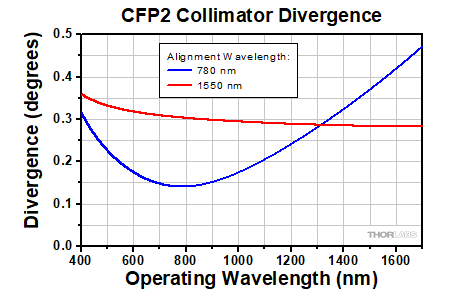
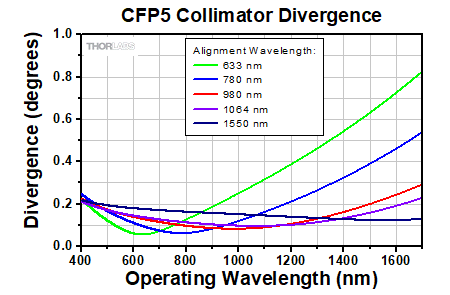
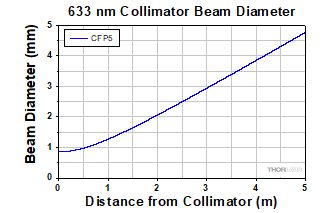
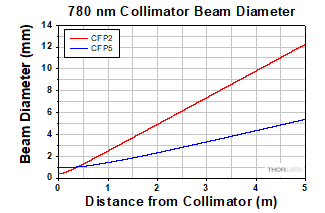
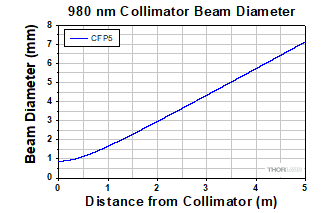
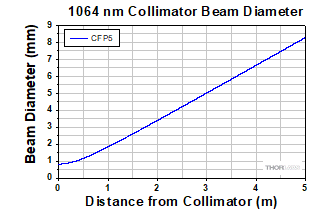
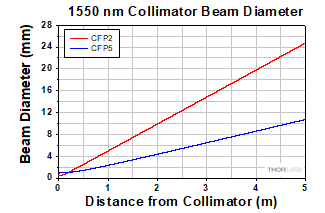

 PM Pigtailed Aspheric Lens Collimators
PM Pigtailed Aspheric Lens Collimators